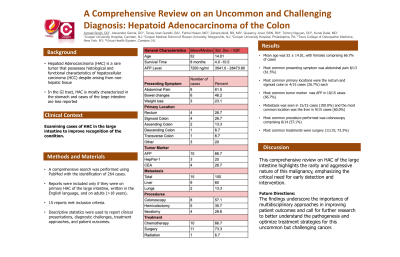Sunday Poster Session
Category: Colon
P0218 - A Comprehensive Review on an Uncommon and Challenging Diagnosis: Hepatoid Adenocarcinoma of the Colon
Sunday, October 27, 2024
3:30 PM - 7:00 PM ET
Location: Exhibit Hall E

Has Audio

Avneet Singh, DO
Cooper University Hospital
Camden, NJ
Presenting Author(s)
Avneet Singh, DO1, Alexander Garcia, DO1, Tanay-Veer Gandhi, BA2, Fariha Hasan, MD3, Zehara Abidi, BS, MS4, Queenzy Jover, BSN, RN5, Tommy Nguyen, DO3, Kunal Dalal, MD1
1Cooper University Hospital, Camden, NJ; 2Cooper Medical School of Rowan University, Morganville, NJ; 3Cooper University Hospital, Philadelphia, PA; 4Touro College of Osteopathic Medicine, New York, NY; 5Virtua Health System, Camden, NJ
Introduction: Hepatoid Adenocarcinoma (HAC) is a rare tumor that possesses histological and functional characteristics of hepatocellular carcinoma (HCC) despite arising from non-hepatic tissue. In the GI tract, HAC is mostly characterized in the stomach and cases of the large intestine are less reported. Here we examine the available cases of HAC in the large intestine to improve recognition of the condition.
Methods: A comprehensive search was performed using PubMed with the identification of 264 cases. Reports were included only if they were on primary HAC of the large intestine, written in the English language, and on adults ( >18 years). 15 reports met inclusion criteria. Descriptive statistics were used to report clinical presentations, diagnostic challenges, treatment approaches, and patient outcomes.
Results: Of the 15 cases, the mean age was 52 ± 14.01, with females comprising 66.7% of cases. The most common presenting symptom was abdominal pain 8/13 (61.5%), while bowel changes and weight loss were seen in 6/13 cases (46.2%) and 3/13 cases (23.1%), respectively. The most common primary locations were the rectum, sigmoid colon and ascending colon in 4/15 cases (26.7%) each. Other locations were the descending colon (2/15) and transverse colon (1/15). The most common tumor marker was AFP in 10/15 cases (66.7%) with a median serum level of 7200 ng/ml (IQR: 3541.0 - 28473.80, n=10), while HepPar-1 and CEA were seen among 3/15 patients (20.0%) and 4/15 patients (26.7%), respectively. Metastasis was seen in 15/15 cases (100.0%) and the most common location was the liver in 9/15 cases (60.0%) followed by the lungs in 2/15 (13.3%) cases. The most common procedure performed was colonoscopy comprising 8/14 (57.1%) while hemicolectomy and ileostomy were performed in 5/14 (35.7%) and 4/14 (28.6%) of cases, respectively. The most common treatments were surgery (11/15; 73.3%) and chemotherapy (10/15; 66.7%). The median survival time amongst the patients was 8 months (IQR: 4 - 10.5, n=15).
Discussion: This comprehensive review on HAC of the large intestine highlights the rarity and aggressive nature of this malignancy, emphasizing the critical need for early detection and intervention. The findings underscore the importance of multidisciplinary approaches in improving patient outcomes and call for further research to better understand the pathogenesis and optimize treatment strategies for this uncommon but challenging cancer.
Disclosures:
Avneet Singh, DO1, Alexander Garcia, DO1, Tanay-Veer Gandhi, BA2, Fariha Hasan, MD3, Zehara Abidi, BS, MS4, Queenzy Jover, BSN, RN5, Tommy Nguyen, DO3, Kunal Dalal, MD1. P0218 - A Comprehensive Review on an Uncommon and Challenging Diagnosis: Hepatoid Adenocarcinoma of the Colon, ACG 2024 Annual Scientific Meeting Abstracts. Philadelphia, PA: American College of Gastroenterology.
1Cooper University Hospital, Camden, NJ; 2Cooper Medical School of Rowan University, Morganville, NJ; 3Cooper University Hospital, Philadelphia, PA; 4Touro College of Osteopathic Medicine, New York, NY; 5Virtua Health System, Camden, NJ
Introduction: Hepatoid Adenocarcinoma (HAC) is a rare tumor that possesses histological and functional characteristics of hepatocellular carcinoma (HCC) despite arising from non-hepatic tissue. In the GI tract, HAC is mostly characterized in the stomach and cases of the large intestine are less reported. Here we examine the available cases of HAC in the large intestine to improve recognition of the condition.
Methods: A comprehensive search was performed using PubMed with the identification of 264 cases. Reports were included only if they were on primary HAC of the large intestine, written in the English language, and on adults ( >18 years). 15 reports met inclusion criteria. Descriptive statistics were used to report clinical presentations, diagnostic challenges, treatment approaches, and patient outcomes.
Results: Of the 15 cases, the mean age was 52 ± 14.01, with females comprising 66.7% of cases. The most common presenting symptom was abdominal pain 8/13 (61.5%), while bowel changes and weight loss were seen in 6/13 cases (46.2%) and 3/13 cases (23.1%), respectively. The most common primary locations were the rectum, sigmoid colon and ascending colon in 4/15 cases (26.7%) each. Other locations were the descending colon (2/15) and transverse colon (1/15). The most common tumor marker was AFP in 10/15 cases (66.7%) with a median serum level of 7200 ng/ml (IQR: 3541.0 - 28473.80, n=10), while HepPar-1 and CEA were seen among 3/15 patients (20.0%) and 4/15 patients (26.7%), respectively. Metastasis was seen in 15/15 cases (100.0%) and the most common location was the liver in 9/15 cases (60.0%) followed by the lungs in 2/15 (13.3%) cases. The most common procedure performed was colonoscopy comprising 8/14 (57.1%) while hemicolectomy and ileostomy were performed in 5/14 (35.7%) and 4/14 (28.6%) of cases, respectively. The most common treatments were surgery (11/15; 73.3%) and chemotherapy (10/15; 66.7%). The median survival time amongst the patients was 8 months (IQR: 4 - 10.5, n=15).
Discussion: This comprehensive review on HAC of the large intestine highlights the rarity and aggressive nature of this malignancy, emphasizing the critical need for early detection and intervention. The findings underscore the importance of multidisciplinary approaches in improving patient outcomes and call for further research to better understand the pathogenesis and optimize treatment strategies for this uncommon but challenging cancer.
Disclosures:
Avneet Singh indicated no relevant financial relationships.
Alexander Garcia indicated no relevant financial relationships.
Tanay-Veer Gandhi indicated no relevant financial relationships.
Fariha Hasan indicated no relevant financial relationships.
Zehara Abidi indicated no relevant financial relationships.
Queenzy Jover indicated no relevant financial relationships.
Tommy Nguyen indicated no relevant financial relationships.
Kunal Dalal indicated no relevant financial relationships.
Avneet Singh, DO1, Alexander Garcia, DO1, Tanay-Veer Gandhi, BA2, Fariha Hasan, MD3, Zehara Abidi, BS, MS4, Queenzy Jover, BSN, RN5, Tommy Nguyen, DO3, Kunal Dalal, MD1. P0218 - A Comprehensive Review on an Uncommon and Challenging Diagnosis: Hepatoid Adenocarcinoma of the Colon, ACG 2024 Annual Scientific Meeting Abstracts. Philadelphia, PA: American College of Gastroenterology.
